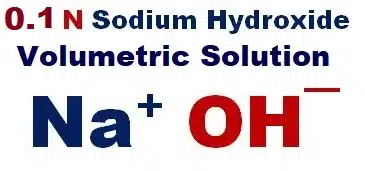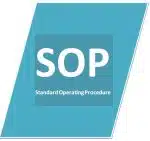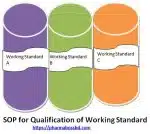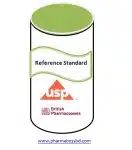Learn how to prepare and standardize 0.1 N Sodium Hydroxide VS (Volumetric Solution) as per the United States Pharmacopoeia (USP) in the quality control laboratory.

Materials Required
1. Sodium hydroxide (NaOH) pellets (high purity)
2. Carbon dioxide-free water (freshly boiled and cooled distilled or deionized water)
3. Potassium hydrogen phthalate (KHP)
4. Analytical balance
5. Volumetric flask (1 L) 1000 mL
6. Burette and pipettes
7. pH indicator (e.g., phenolphthalein)
Calculation for Preparing 0.1 N NaOH
The number of equivalents of solute per liter of solution is identified as normality (N).
NaOH has a molar mass of 40 g/mol, and since it provides one mole of hydroxide ions (OH⁻) per mole, it has an equivalent weight of 40 g/eq.
To make 0.1 N NaOH solution:
| Normality = | grams of solute |
| equivalent weight X volume of solution in liter |
So,
grams of NaOH = Normality x Equivalent weight x volume of solution in liters
Where,
Normality = 0.1 N
Equivalent weight of NaOH = 40 g/eq
Volume of solution = depends on how much you want to prepare (e.g., 1 liter, 500 mL, etc.).
Now calculate for 1 liter of 0.1 N NaOH solution.
grams of NaOH = 0.1 N×40 g/eq×1liter
= 0.1 x 40 x 1
= 4 grams of NaOH
So, to prepare 1 liter of a 0.1 N NaOH solution, you need 4 grams of NaOH
Procedure for Preparation 0.1 N NaOH
1. Weigh approximately 4.0 g of sodium hydroxide solution (NaOH) pellets on an analytical balance.
2. Carefully transfer the sodium hydroxide solution (NaOH) pellets into a 1000 ml of volumetric flask containing about 300 mL of carbon dioxide-free water.
3. Stir to dissolve the sodium hydroxide solution NaOH completely.
4. Fill the solution to the 1000 ml mark with carbon dioxide-free water.
5. Stopper the flask and mix well by inverting it several times.
Standardization of 0.1 N Sodium Hydroxide Solution (NaOH)
The solution must be standardized against a primary standard, such as potassium hydrogen phthalate (KHP), which is a stable, high-purity compound used for standardization.
Procedure
1. Accurately weigh about 0.500 g of potassium hydrogen phthalate, previously crushed and dried at 120°C temperature for 2 hours.
2. Now transfer the weighed potassium hydrogen phthalate in 250 ml of conical flask with 75 ml of carbon dioxide free water.
3. Dissolve it properly.
4. Add two drops of phenolphthalein TS indicator to the solution.
5. Titrate the potassium hydrogen phthalate (KHP) solution with the 0.1 N sodium hydroxide solution from the burette to the production of a permanent pink color.
6. Record the volume of sodium hydroxide solution (NaOH) used (Titrant).
Each 20.422 mg of potassium hydrogen phthalate is equivalent to 1 ml of 0.1 N sodium Hydroxide solution.
Factor Calculation of Normality
Use the following equation to calculate the exact normality of the NaOH solution:
N = grams of benzoic acid / 0.020422 X mL of sodium hydroxide solution
| N = | grams of potassium hydrogen phthalate |
| 0.020422 X mL of sodium hydroxide solution |
Note: Triplicate the titration for standardization and average the result.
Standardization of 0.1 N NaOH with Benzoic acid
Procedure
1. Accurately weigh about 0.200 g of benzoic acid
2. Now transfer the weighed benzoic acid in 50/100 ml of conical flask with 15 ml of carbon dioxide free water.
3. Dissolve it properly.
4. Add two drops of phenolphthalein TS indicator to the solution.
5. Titrate the benzoic acid solution with the 0.1 N sodium hydroxide solution from the burette to the production of a pale pink color.
6. Record the volume of NaOH used (Titrant).
Each 122.10 mg of benzoic acid is equivalent to 1 ml of 0.1 N sodium Hydroxide solution.
Factor Calculation of Normality
Use the following equation to calculate the exact normality of the NaOH solution:
N = grams of benzoic acid / 0.10211 X mL of sodium hydroxide solution
| N = | grams of benzoic acid | |
| 0.1221 X mL of sodium hydroxide solution |
Note: Triplicate the titration for standardization and average the result.
Labeling and Storage
1. Label the solution with its concentration and the date of preparation.
2. Store the NaOH solution in a tightly closed container to avoid absorption of carbon dioxide from the air, which could affect its normality.
Precautions
1. Always use gloves and eye protection when handling NaOH, as it is a strong base and can cause burns.
2. Ensure that the water used is free from carbon dioxide, as NaOH readily absorbs CO₂ to form sodium carbonate, which can alter the concentration.
Reference: United State Pharmacopoeia (USP) volume 4
Related Topic: Prepare and Standardize 0.5 N Sodium Hydroxide VS

Abdus Sobhan Salim is professional experienced pharmacist in pharmaceuticals, author and founder of pharmabossbd.com, the first Bangladeshi pharmaceutical blogger since 2019.



